Abstract
We review our studies on the role of complement (C) as mediator of xenograft hyperacute rejection using an in vitro model consisting of porcine endothelial cells as target and human serum as source of natural antibodies and C. Cytotoxicity of endothelial cells required IgM antibodies to porcine endothelial cells, and the classical pathway and membrane attack complex of C. These findings correlated with in vivo results of porcine organs transplanted into rhesus monkeys, which showed a) co-deposition of IgM, C3, C4 and C9, along blood vessels of rejecting organs, with trace deposits of factors B or P, and b) minimal deposition of IgM and C components in transplants with prolonged survival that were performed in rhesus monkeys depleted of natural antibodies but with normal C levels. Human serum causes activation of porcine endothelial cells manifested by release of heparan sulfate proteoglycan. Heparan sulfate release was induced by C5a alone. A new approach to avert xenograft hyperacute rejection was tested. To inhibit cytotoxicity of porcine endothelial cells by human C, the membrane-associated C inhibitor decay-accelerating factor (DAF) of human origin was incorporated into endothelial cells. Human DAF was able to efficiently inhibit C-mediated killing of porcine endothelial cells, suggesting that the use of DAF and other C inhibitors could be used to interfere with C-mediated xenograft hyperacute rejection.
Full text
PDF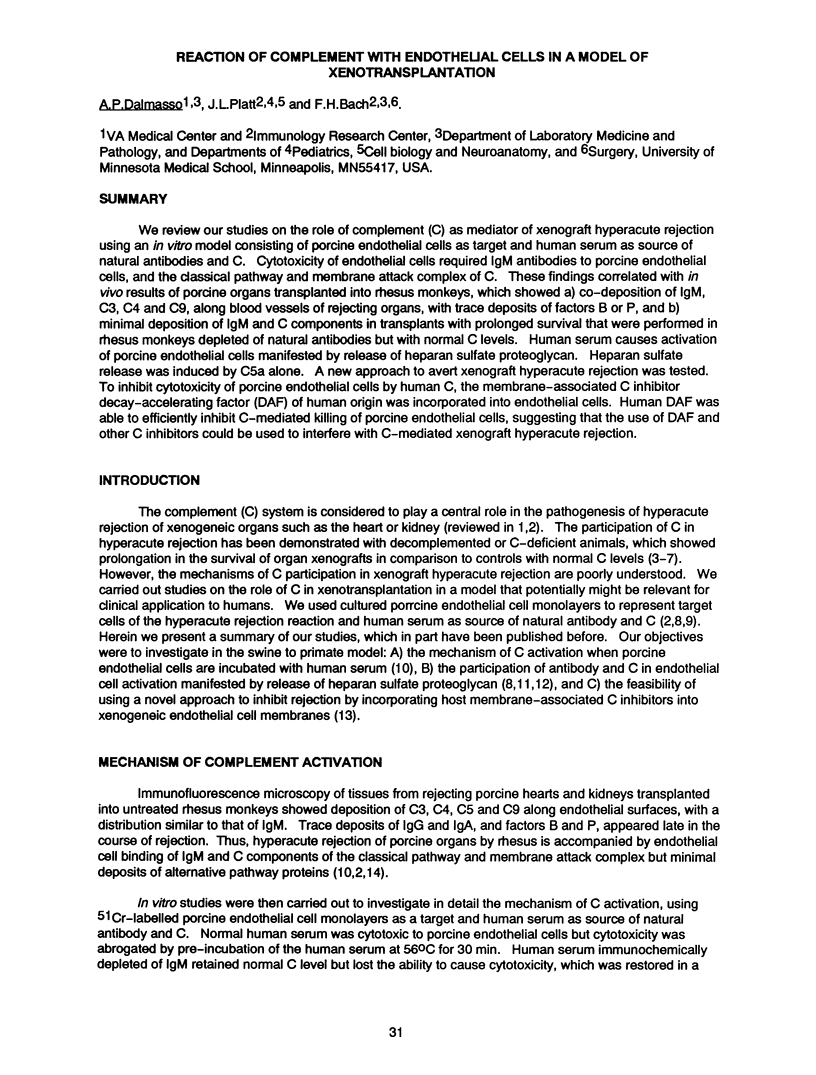
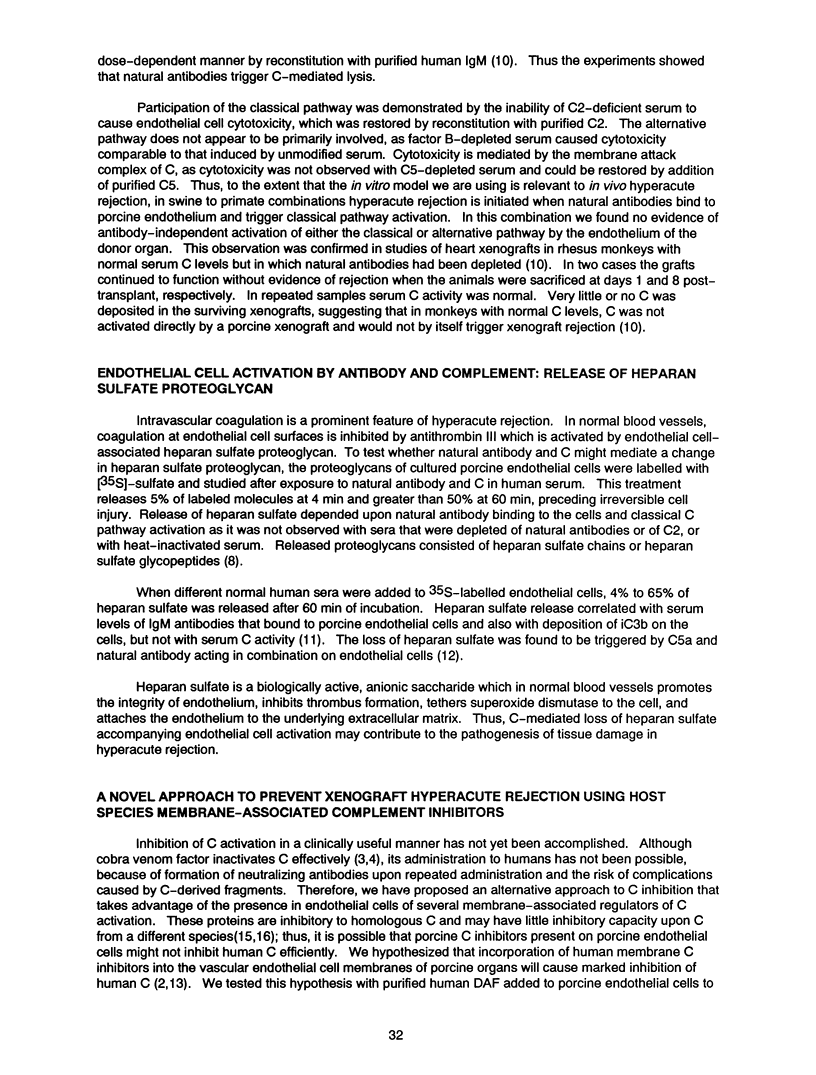
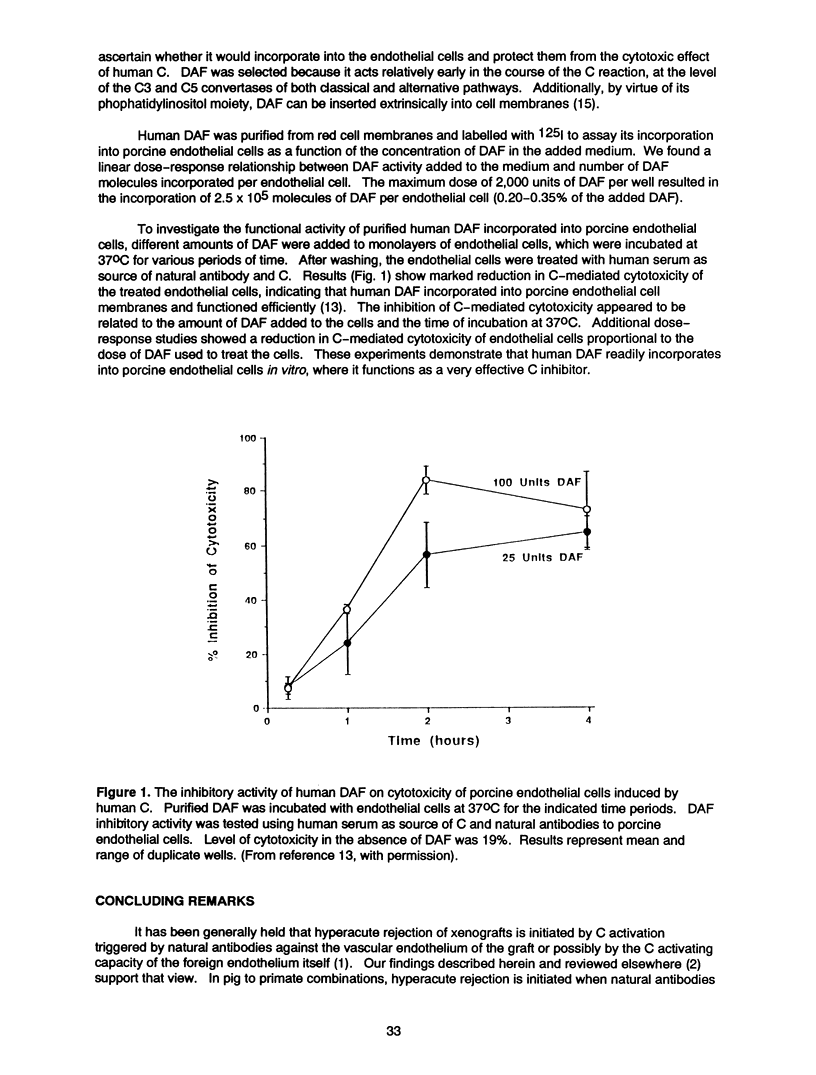
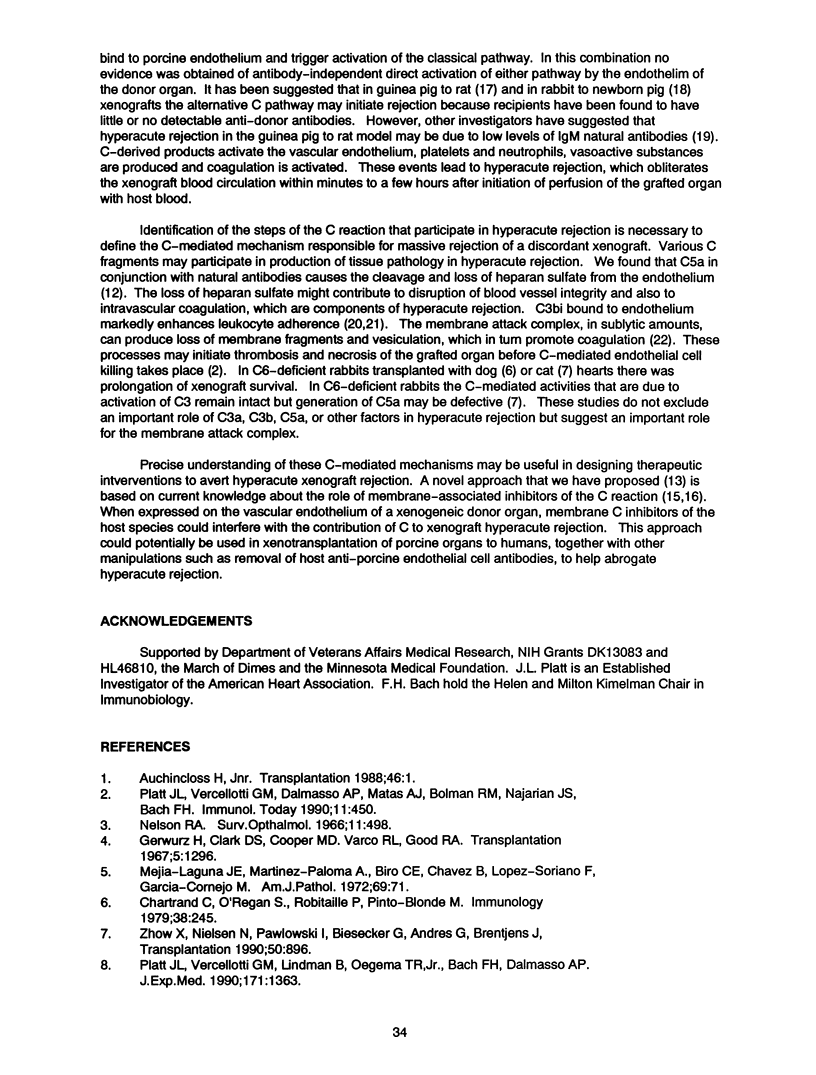
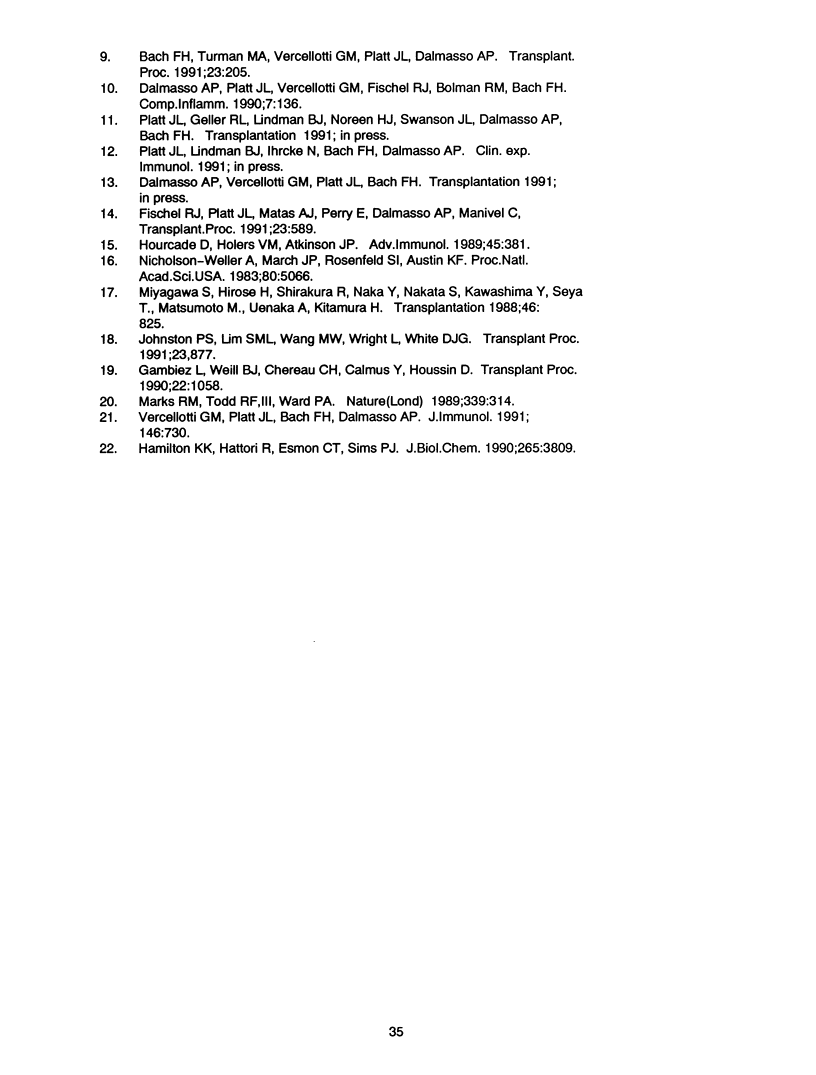
Selected References
These references are in PubMed. This may not be the complete list of references from this article.
- Bach F. H., Turman M. A., Vercellotti G. M., Platt J. L., Dalmasso A. P. Accommodation: a working paradigm for progressing toward clinical discordant xenografting. Transplant Proc. 1991 Feb;23(1 Pt 1):205–207. [PubMed] [Google Scholar]
- Fischel R. J., Platt J. L., Matas A. J., Perry E., Dalmasso A. P., Manivel C., Najarian J. S., Bach F. H., Bolman R. M., 3rd Prolonged survival of a discordant cardiac xenograft in a rhesus monkey. Transplant Proc. 1991 Feb;23(1 Pt 1):589–590. [PubMed] [Google Scholar]
- Gewurz H., Clark D. S., Cooper M. D., Varco R. L., Good R. A. Effect of cobra venom-induced inhibition of complement activity on allograft and xenograft rejection reactions. Transplantation. 1967 Sep 5;5(5):1296–1303. doi: 10.1097/00007890-196709000-00008. [DOI] [PubMed] [Google Scholar]
- Hamilton K. K., Hattori R., Esmon C. T., Sims P. J. Complement proteins C5b-9 induce vesiculation of the endothelial plasma membrane and expose catalytic surface for assembly of the prothrombinase enzyme complex. J Biol Chem. 1990 Mar 5;265(7):3809–3814. [PubMed] [Google Scholar]
- Hourcade D., Holers V. M., Atkinson J. P. The regulators of complement activation (RCA) gene cluster. Adv Immunol. 1989;45:381–416. doi: 10.1016/s0065-2776(08)60697-5. [DOI] [PubMed] [Google Scholar]
- Johnston P. S., Lim S. M., Wang M. W., Wright L., White D. J. Hyperacute rejection of xenografts in the complete absence of antibody. Transplant Proc. 1991 Feb;23(1 Pt 1):877–879. [PubMed] [Google Scholar]
- Marks R. M., Todd R. F., 3rd, Ward P. A. Rapid induction of neutrophil-endothelial adhesion by endothelial complement fixation. Nature. 1989 May 25;339(6222):314–317. doi: 10.1038/339314a0. [DOI] [PubMed] [Google Scholar]
- Miyagawa S., Hirose H., Shirakura R., Naka Y., Nakata S., Kawashima Y., Seya T., Matsumoto M., Uenaka A., Kitamura H. The mechanism of discordant xenograft rejection. Transplantation. 1988 Dec;46(6):825–830. doi: 10.1097/00007890-198812000-00007. [DOI] [PubMed] [Google Scholar]
- Nelson R. A., Jr A new concept of immunosuppression in hypersensitivity reactions and in transplantation immunity. Surv Ophthalmol. 1966 Aug;11(4):498–505. [PubMed] [Google Scholar]
- Nicholson-Weller A., March J. P., Rosenfeld S. I., Austen K. F. Affected erythrocytes of patients with paroxysmal nocturnal hemoglobinuria are deficient in the complement regulatory protein, decay accelerating factor. Proc Natl Acad Sci U S A. 1983 Aug;80(16):5066–5070. doi: 10.1073/pnas.80.16.5066. [DOI] [PMC free article] [PubMed] [Google Scholar]
- O'Regan C. C., Robitaille P., Pinto-Blonde M., Chartrand C. Delayed rejection of cardiac xenografts in C6-deficient rabbits. Immunology. 1979 Oct;38(2):245–248. [PMC free article] [PubMed] [Google Scholar]
- Platt J. L., Vercellotti G. M., Dalmasso A. P., Matas A. J., Bolman R. M., Najarian J. S., Bach F. H. Transplantation of discordant xenografts: a review of progress. Immunol Today. 1990 Dec;11(12):450–457. doi: 10.1016/0167-5699(90)90174-8. [DOI] [PubMed] [Google Scholar]
- Platt J. L., Vercellotti G. M., Lindman B. J., Oegema T. R., Jr, Bach F. H., Dalmasso A. P. Release of heparan sulfate from endothelial cells. Implications for pathogenesis of hyperacute rejection. J Exp Med. 1990 Apr 1;171(4):1363–1368. doi: 10.1084/jem.171.4.1363. [DOI] [PMC free article] [PubMed] [Google Scholar]
- Vercellotti G. M., Platt J. L., Bach F. H., Dalmasso A. P. Neutrophil adhesion to xenogeneic endothelium via iC3b. J Immunol. 1991 Jan 15;146(2):730–734. [PubMed] [Google Scholar]
- Zhow X. J., Niesen N., Pawlowski I., Biesecker G., Andres G., Brentjens J., Milgram F. Prolongation of survival of discordant kidney xenografts by C6 deficiency. Transplantation. 1990 Nov;50(5):896–898. [PubMed] [Google Scholar]


